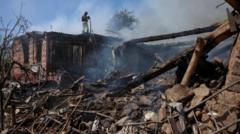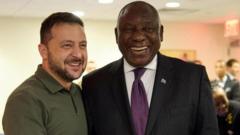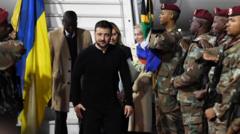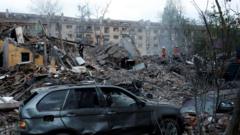Amid a flurry of talks involving key international players, the feasibility of a peace plan emerges fraught with complexities and challenges.
### US Diplomatic Push in Ukraine War: Uneasy Prospects for Peace

### US Diplomatic Push in Ukraine War: Uneasy Prospects for Peace
Increased diplomatic efforts by the US aim to resolve the ongoing Ukraine conflict, but the path ahead remains uncertain.
The urgency to halt hostilities in Ukraine is becoming more pronounced, with representatives from the UK, Germany, France, Ukraine, and the US convening in London for discussions. Meanwhile, Donald Trump's special envoy, Steve Witkoff, is set to engage in his fourth meeting with President Putin in Moscow. Despite these high-level discussions, there is still ambiguity surrounding the potential outcomes and the effectiveness of these diplomatic initiatives.
Earlier, the US had outlined a straightforward strategy for peace, emphasizing a 30-day unconditional ceasefire and subsequent negotiations for a lasting resolution. Ukraine expressed its willingness to comply, even conceding the necessity of waiving long-term security guarantees to facilitate a halt in military actions. However, Russia's conditions proved to be a sticking point, as President Putin demanded that "root causes" of the conflict—including NATO expansion and Ukrainian independence—must first be addressed.
The US is presently navigating a proposed ceasefire framework that suggests Russia would cease military advancements while renouncing claims over four eastern Ukrainian regions. In return, the US would acknowledge these territories as under Russian control and ratify Crimea as part of Russia. Moreover, Ukraine would be restricted from pursuing NATO membership, while the US might oversee the Zaporizhzhia nuclear plant, distributing its electricity to both Russian-occupied and Ukrainian territories.
Despite these negotiations, the proposal has significant hurdles. President Zelensky's firm stance against acknowledging Crimea as Russian territory remains a critical issue, as any such concession would necessitate broader public support within Ukraine. European allies are equally resistant to the idea, fearing it would violate established international norms regarding territorial integrity.
Diplomatic circles remain cautiously optimistic, with some arguing that dialogue could still yield results if trust can be established between the conflicting parties. Nonetheless, considerable gaps persist within the proposed deal, particularly regarding military rearming, Ukraine's actual military capacity, and the status of economic sanctions against Russia.
In conclusion, while the diplomatic landscape is evolving, fundamental disagreements remain. Ukraine seeks a conditional ceasefire, the US aims for rapid agreements, and Russia insists on extensive discussions over a detailed peace framework. As of now, meaningful consensus appears distant, echoing the Russian adage, "nothing is agreed until everything is agreed."
Earlier, the US had outlined a straightforward strategy for peace, emphasizing a 30-day unconditional ceasefire and subsequent negotiations for a lasting resolution. Ukraine expressed its willingness to comply, even conceding the necessity of waiving long-term security guarantees to facilitate a halt in military actions. However, Russia's conditions proved to be a sticking point, as President Putin demanded that "root causes" of the conflict—including NATO expansion and Ukrainian independence—must first be addressed.
The US is presently navigating a proposed ceasefire framework that suggests Russia would cease military advancements while renouncing claims over four eastern Ukrainian regions. In return, the US would acknowledge these territories as under Russian control and ratify Crimea as part of Russia. Moreover, Ukraine would be restricted from pursuing NATO membership, while the US might oversee the Zaporizhzhia nuclear plant, distributing its electricity to both Russian-occupied and Ukrainian territories.
Despite these negotiations, the proposal has significant hurdles. President Zelensky's firm stance against acknowledging Crimea as Russian territory remains a critical issue, as any such concession would necessitate broader public support within Ukraine. European allies are equally resistant to the idea, fearing it would violate established international norms regarding territorial integrity.
Diplomatic circles remain cautiously optimistic, with some arguing that dialogue could still yield results if trust can be established between the conflicting parties. Nonetheless, considerable gaps persist within the proposed deal, particularly regarding military rearming, Ukraine's actual military capacity, and the status of economic sanctions against Russia.
In conclusion, while the diplomatic landscape is evolving, fundamental disagreements remain. Ukraine seeks a conditional ceasefire, the US aims for rapid agreements, and Russia insists on extensive discussions over a detailed peace framework. As of now, meaningful consensus appears distant, echoing the Russian adage, "nothing is agreed until everything is agreed."




















